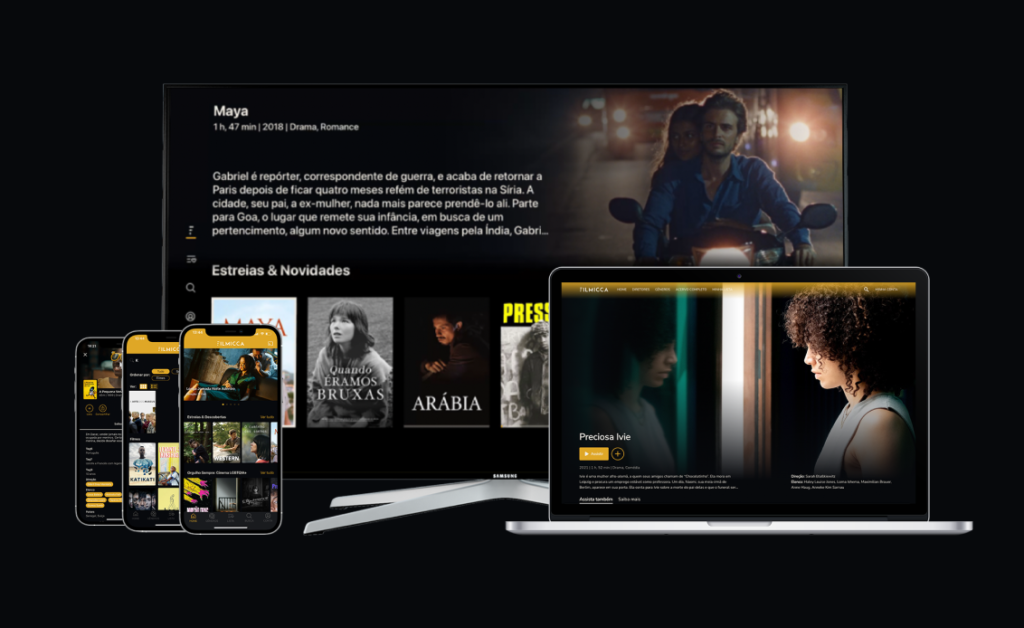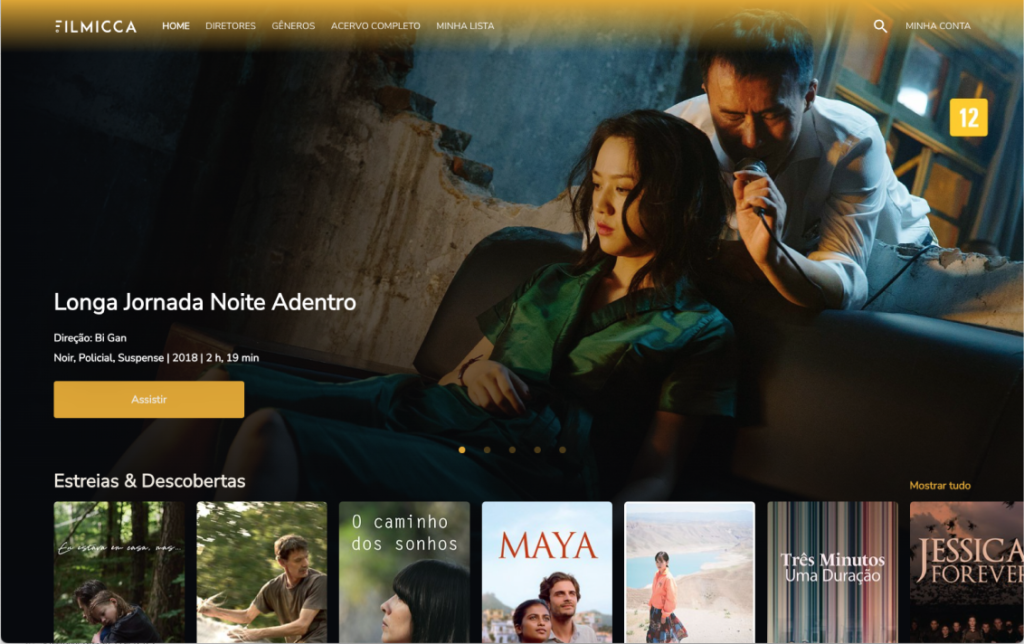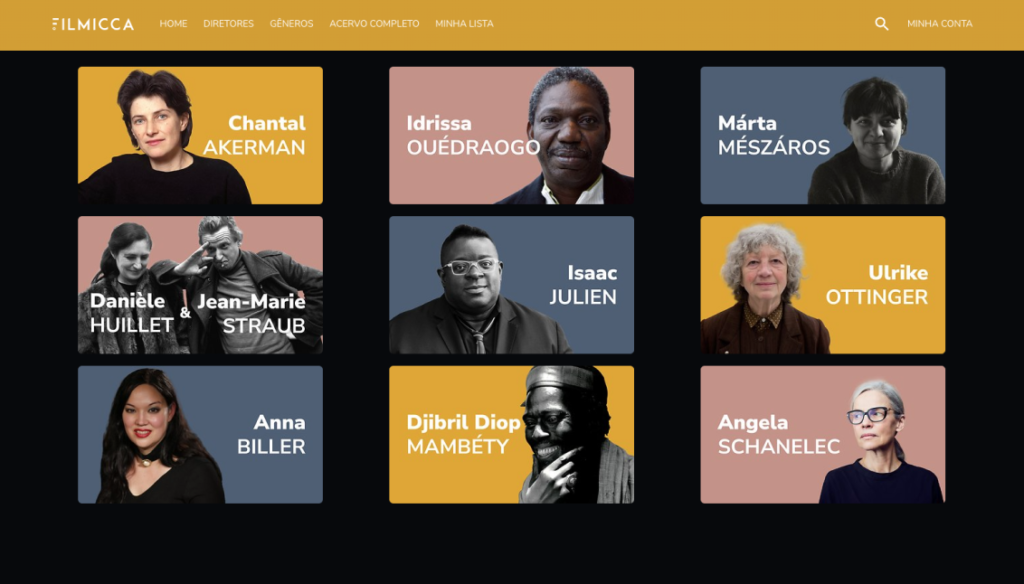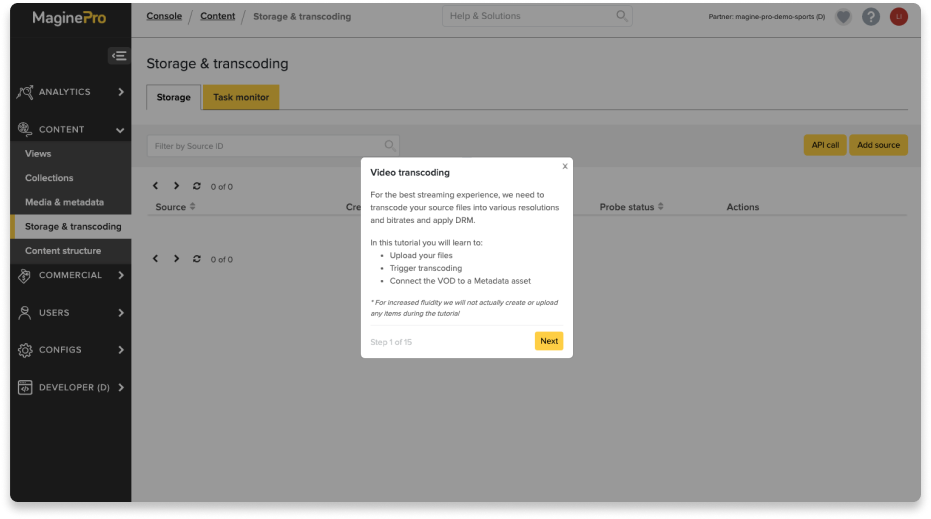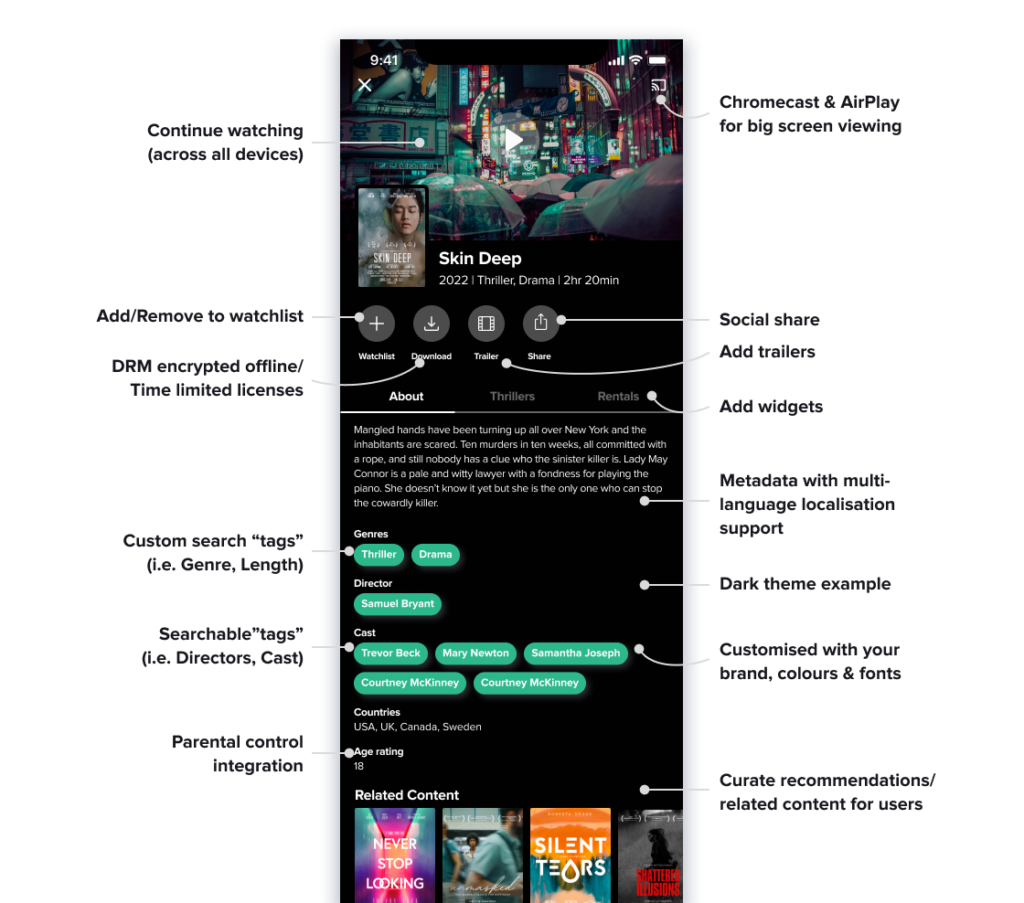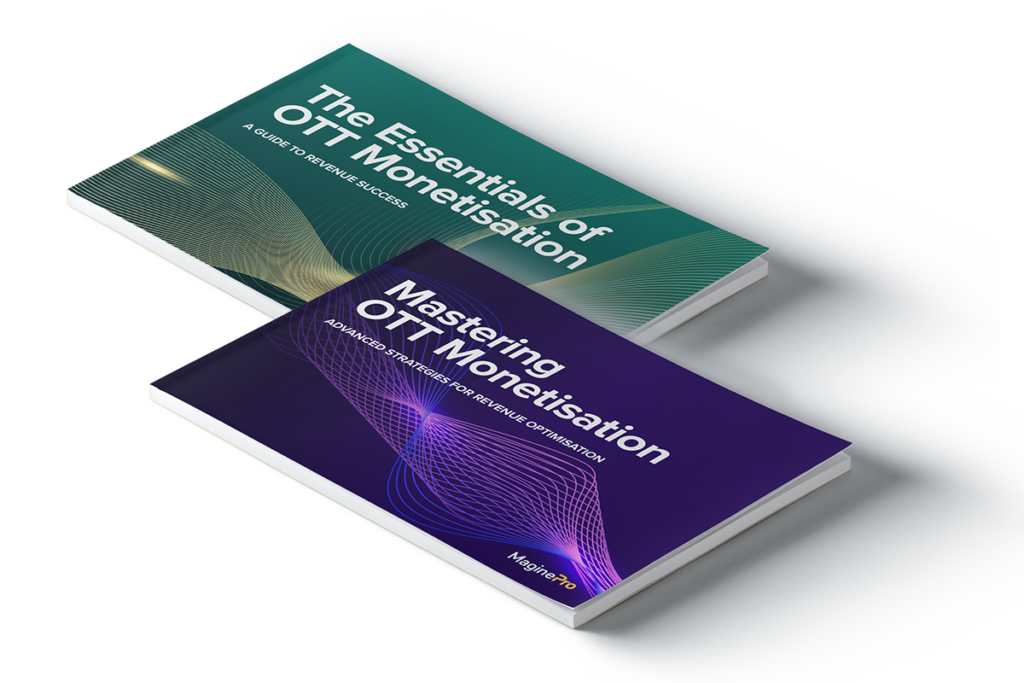Introducing Filmicca by Magine Pro
Filmicca is the ultimate destination for fans of authorial and cult cinema, offering an eclectic mix of classics and contemporary works. This independent Brazilian streaming service stands out for its celebration of diversity, featuring films by women, LGBTQIA+ narratives, black stories, and emerging filmmakers. With exciting weekly releases that include exclusive titles and festival favourites, Filmicca is set to entertain audiences across Brazil.
In partnership with Magine Pro, Filmicca has seamlessly transitioned its streaming service and extensive library to the Magine Pro OTT Platform, ensuring flawless integration across mobile applications and big screens. This migration prioritised minimal downtime and user disruption, allowing Brazilian audiences to continue enjoying uninterrupted access to a wide array of high-quality, diverse films.
Dive into our case study to explore Filmicca’s journey of enhancing its service and user experience. And, if you’re curious to experience the vibrant world of Filmicca, here’s a sneak peek at the service.
If you want to find out more about Magine Pro’s OTT platform and specialist video streaming services, get in touch! We can help you enhance your existing service or help you launch something entirely new. You can also check out our experience and more of our case studies here.
Stay in the loop with our latest releases and industry updates by following us on LinkedIn. Alternatively, sign up for our e-newsletter to have them delivered directly to your inbox.
Magine Pro Nominated for Streaming Media Innovation Award
We’re honoured to have been nominated for the Streaming Media European Innovation Awards 2024!
The Magine Pro OTT Platform is in the running for the OTT Video Platform/Service category in this prestigious competition.
An OTT Platform UX that helps niche content providers thrive
The nomination recognizes the platform’s ability to support niche content providers in going direct to consumers with a video streaming service that matches up to the user experience offered by their giant rivals like Netflix and Disney+.
Minimising migration mayhem – three weeks to launch!
Over the past year, Magine Pro has significantly optimised its platform, focusing on enabling smooth, quick, and seamless migration for these customers, to ensure that the transition is as non-disruptive as possible. This is achieved through expert support, proven processes, and our highly configurable application code base.
The efficacy of these enhancements in product and processes was evident when Magine Pro recently migrated one customer, a niche SVOD service based in South America, off their existing platform provider and onto the Magine Pro OTT platform in a little over three weeks from start to finish. This migration included the creation of Smart TV apps for both LG and Samsung devices, both of which were submitted to the relevant app stores for approval within three weeks of the contract signature.
Future-proofing OTT services with Magine Pro’s OTT Platform
One of the key reasons why OTT services choose to migrate to Magine Pro is its advanced hybrid monetisation capabilities, which adeptly cater to diverse revenue generation strategies within the same service framework. This flexibility allows service providers to offer a blend of AVOD, SVOD, TVOD, and even bespoke models like electronic sell-through, all managed through a single interface. This not only simplifies the backend operations but also enhances the consumer experience by providing varied content consumption options. By integrating leading payment gateways and supporting multiple currencies, Magine Pro ensures a frictionless payment experience for end-users globally, crucial for customer retention and acquisition in a competitive market.
Vote for Magine Pro in the Streaming Media Innovation Awards
The final shortlist for these awards is determined by public vote. You can vote for Magine Pro until 24th July 2024 here: https://www.streamingmediaglobal.com/Innovation-Awards
The winners will be announced in September.
If you’d like to know more about the Magine Pro OTT platform, why not book a meeting at IBC 2024?
Navigating a Seamless OTT Platform Switch: Lessons from a Recent Success

Understanding the Migration Landscape
For any OTT service provider, the need to migrate often arises because their existing platform can’t meet their growth requirements. There can be many sticking points that finally trigger the search for a new provider – from scalability and monetisation flexibility to the quality of the user experience. In the current climate, however, the main driver is definitely the desire to reach Smart TVs.
Big screen was certainly the priority for our most recent new customer, an OTT service based in Latin America. They made the switch to Magine Pro’s OTT platform because they wanted to capture a share of the booming market for streaming content on Connected TVs. Their first goal was to have apps on the market-leading devices – Samsung and LG – but also to have the scope to reach other brands of TV in the near future.
The biggest challenge in this project was the timescales. For their own business reasons, the customer wanted to go live with their new apps on the Magine Pro platform in under four weeks. Anyone who’s launched or migrated an OTT platform will know that’s a tall order, but it’s totally achievable with the Magine Pro platform, as we demonstrated by going live in 3.5 weeks! Here’s how we did it:
Start Strong: The Step-by-Step Approach to OTT Upgrades
My colleague Marcus Lindén has already blogged about some of the top technical considerations for any OTT service looking to switch platforms and offered his low-stress guide to getting it done. For me, the key to success in any customer engagement is great communication. This starts with our onboarding process where we outline:
- All the tasks involved
- Roles and responsibilities for both Magine Pro and the customer
- Where the customer can find how-to documentation
We’ve spent a lot of time optimising our customer-facing documentation so that everyone is clear on their roles and responsibilities within the project. The onboarding process also includes a full demonstration of the Magine Pro Console – our online tool that is used by our customers to manage the configuration of their apps and curate their content. Thankfully, the Console is super-easy to use, but it also includes in-app FAQs and help sections so our customers can get self-service support.
The Step-by-Step approach to a successful OTT Upgrade
In any migration process, there are some tasks that take longer than others. These typically include ingestion of content and getting app store approval from the Smart TV manufacturers. So, we always highlight the importance of starting on these tasks as soon as possible.
In the case of our recent client, they had a huge library of movies to upload, so I advised them on prioritising their “must-have” content for launch. By working on that first, they were ready to make the switch as soon as possible, leaving the longer-tail movies to be ingested after launch if necessary.
Regular Engagement: A Recipe for Success
It is possible to successfully move an OTT service to the Magine Pro platform with just the onboarding meeting and the provision of our documentation. However, with such a tight timeline, we agreed on a schedule of very regular internal and customer meetings to check in and ensure everyone was continuously aligned on the project. These sessions served as crucial touchpoints where progress was reviewed, challenges addressed in real-time, and next steps defined collaboratively.
You might be thinking that the customer needs to have a big technical team in place to manage their side of the process, but that couldn’t be further from the truth. In fact, our recent customer has just three full-time staff: two working on content and one on marketing. They were very responsive and engaged with the project and between them were able to hit all the deadlines required to make the timeline a reality.
Managing The App Store Approvals Process
With the various app stores, it’s the customer who owns the relationship with the likes of Apple, Google etc. so we can help, but we can’t do the whole process for them. For the recent customer, this was the first time they’d worked with LG and Samsung, so it was important to get their accounts created early in the process. While we create and test the apps, it’s the customer who has to submit them and all supporting promotional materials.
For the Smart TV companies, there’s the additional burden of creating a PowerPoint presentation that outlines how the app functions to support them in their approvals testing. We’ve done this many times before, so in our very first meeting to onboard the customer, I’ll outline the whole process with them and walk them through the different images, text, and documentation that will need to be uploaded through each app store.
One aspect of launching on Smart TVs that is familiar to us, but came as a surprise to our latest customer as it has many other OTT services, is the issue of backwards compatibility on older screens. Although our apps work well on older models of Connected TV, the manufacturers typically require a separate contract before they’ll release an app to devices launched in 2019 or earlier. This is, like the app store submission process itself, something we can advise on, but a process the customer must manage themselves. It’s another thing they need to work on as soon as possible to avoid any delays.
Getting Subscribers on Board: Reducing Friction To Mitigate Churn
The final step before the customer goes live on the Magine OTT platform is to migrate their user data across from their old platform. We’ve optimised our migration scripts for speed and efficiency. In our most recent project, we were able to transfer all the user data (with the exception of passwords) in around two hours which minimised the downtime for subscribers before we could get them going on the new apps.
The timing of this process is essential, but so is the way it’s communicated. Any kind of confusion or unexpected friction runs the risk of causing subscribers to churn. With our recent project, the customer took our advice to be very proactive in communicating with their subscribers about the upcoming change.
In addition to emails advising users of what was to come, they displayed banners in the existing apps that linked to a landing page which described what the migration process would look like. This was key in getting consumers ready to create their new passwords and explore the new, upgraded user experience. We also provided SEO optimization links that were added to their existing web pages. These ensure users are redirected to the new apps when Googling specific content.
Post-Migration Support and Optimisation
Of course, the initial transition is not the end of the story. Now that this customer is live on the Magine Pro OTT platform, there is still much work to be done. There are more Smart TV apps to be added in the future and further content to be uploaded.
Our Customer Success team continues to support them in the post-migration phase, assisting them with verifying configurations, optimising platform settings, and addressing any post-launch adjustments. This holistic approach ensures that our clients not only go live on time but also thrive in their new digital environment.
Looking Ahead: Lessons Learned and Future Readiness
Reflecting on this specific project, it’s clear that effective communication, meticulous planning, and agile execution are paramount when you’re looking to achieve both speed and quality. While each migration presents unique challenges, we are committed to delivering a seamless transition. If you’re contemplating a migration or seeking to optimise your current OTT setup, contact our experts to talk about your needs.
Don’t Panic! A stress-free guide to upgrading your OTT service

“We’re going to need a bigger boat!” When you’ve outgrown your OTT platform
You probably chose your current all-in-one platform so you could concentrate on content and outsource the many complexities of going OTT to a team of experts. Smart move! You didn’t need to hire your own specialists in UX design, app development, billing, integrations, transcoding etc. But a few years in, you’re starting to feel like you’ve outgrown your existing provider. You want Big Screen apps, flexible monetisation options and a higher-quality UX, but for that – to quote the movie Jaws – “going to need a bigger boat”!
We’ve helped a number of OTT services make the switch to the Magine Pro platform to get all these benefits, and we know that it can be a daunting decision. You’re not just swapping out a single app, billing solution or transcoding tool – you’re switching pretty much everything all at once. And you’re probably in a hurry to make it happen as soon as possible. The good news is that, unlike hunting for Jaws, migrating OTT platforms doesn’t have to be terrifying!
Here’s what we’ve learned from guiding other services through the switch, helping them to move over as quickly as possible, with minimal disruption to both end users and their internal operations.
Ready, Set, Go! What you need in place to make switching fast and fuss free
The work to get a customer switched over to the Magine Pro platform can take as little as two weeks, with daily check-ins between a representative of the customer’s organisation and our customer success team. But to achieve such an expedited timeline, the customer needs to be fully prepared to supply all the necessary information and ensure they have team members who are accountable for key areas of the migration.
How to get your content into your new OTT platform
In our experience, the task that takes up the most time when moving platforms is moving the content itself, including video, metadata and images. So, you’ll want to get started on this process as soon as possible.
When it comes to video, as I described in my previous blog post, you can either ingest the source files for all your existing content, or you can move over the existing DRM-encrypted files. Our advice is to go back to the high-quality source files. It may seem counterintuitive if you’ve already transcoded the content, but every platform has its preferred formats and this is a great opportunity to normalise all your content which may have been uploaded at different times and rendered into different bit-rates. While uploading source files to cloud storage does take time, it’s typically no more time-intensive than uploading all the different renditions of the same file. We advise our customers to use automation to smooth the batch-upload process, rather than requiring someone to supervise manual uploads. Having some scripting skills on hand to support this, even just for a few weeks, will likely increase the velocity of your move to your new platform.
Metadata is the new oil: Maximising discoverability in your new OTT platform
It is crucial that any video service takes the time to get the metadata transfer right when switching to a new OTT platform. In many cases, the existing system is the “source of truth” for all your content metadata, but it’s not always – perhaps you’ve got a separate rights management system that you’ll be exporting from. But wherever you hold your metadata, you’re going to need to ensure it maps accurately to the fields in your new platform. Again, you’ll want to automate this process and we’re often called upon to help our customers with the technicalities of this data transformation.
Trading Up Your OTT User Experience: Big Screen and Small Screen Apps
Although an end-to-end OTT platform relieves you of the responsibility for designing your own apps, there is still a need for some design input from the video service provider. Logos and other image assets need to be provided, including images for the App splash screens. In return, you’ll also need to upload images of the refreshed Apps to the various app stores to promote your service. So while you probably won’t need a designer on your staff to smooth the project along, we do recommend you have someone on the project team who is responsible for sourcing and signing-off the necessary designs and imagery.
Once the apps are ready, we’ll typically push them into the customer’s app store accounts (you’ll need to supply the credentials) but it’s up to the customer to do final testing and actually submit the apps for review and publication.
When it comes to TV apps for the likes of LG or Samsung, you probably already know that the review process is typically much more lengthy than with Google or Apple. If you’re switching platforms to get access to big screen apps for the first time, you can afford to make the jump for all your other apps and wait for the Smart TV app approvals to come through at a later date. If you have existing apps, the approvals process is something you’ll need to take into account when planning your switch-over date. But if you’re working with a partner like Magine Pro who has already published many apps for companies like LG and Samsung, it can be helpful to highlight to them that the apps you’re submitting for review are using exactly the same code-base as other apps they’ve already approved.
Getting to know you: Switching your customers to the new platform
While the high-volume migration of content is happening in the background, and your apps are being approved, another topic to focus on is customer data. The first step is to provide examples of the user details held in your current platform to the new service provider so they can start to match fields and identify any issues.
If, as outlined in my previous blog, you’re bringing over customer accounts but not passwords, a key step is to craft in advance the template emails that will go out to existing users to inform them that they need to create a new password when they log in for the first time after the switch-over. Getting these communications right is key to limiting user friction and the potential for churn during the migration process. At the same time, you’ll also need to configure template emails for all those business-as-usual customer flows such as reset password, payment processed, payment card expired, etc.
Automating the migration of customer data and user accounts between OTT platforms
When you’re ready to switch the users over, automation is once again going to be your friend. Ideally, you’ll have someone on your team with scripting skills and a working knowledge of your existing CRM/billing system. They’ll need to obtain the necessary customer data from your current platform so it can be safely added to your new platform via our migration team to:
- Create a user in the new platform with all relevant information – first name, last name, email address, birth date, location etc. The list will differ per platform.
- Create relevant entitlements for that user that map to their existing entitlements
- Add details of when their next billing cycle is required
On the day nerves: How to handle the actual switchover?
We typically recommend that customers time their switch-over to coincide with the regularly scheduled maintenance window of our cloud provider to ensure all back-ups are clean and in sync. We’ve already touched on the need to migrate the user accounts, but how do you stop any customer purchases or registrations falling through the net while that is going on? Our advice is to pause new sign-ups and purchases just before you take your image of the user database to avoid this problem.
Using automation will minimise the length of time when you’re unable to support customer interactions in this way, in our benchmarking tests, we expect it to take around two hours to migrate 10,000 user accounts, so it should be possible to do this process at a time of day when your service sees the least user traffic.
But in some cases, the existing OTT platform may not be able to disable sign-ups or purchases, so we’ll need to do a careful reconciliation of the delta between exported data and final data in the decommissioned system to avoid customer complaints.
Want to know more? Talk to our experts
As you can see, there’s a lot more to switching OTT platforms than meets the eye, but if you’ve got the right support and a team that’s done it many times before, you’re in safe hands. If you’d like to talk to the Magine Pro team about any of the topics raised in this blog, why not book a meeting.
Why OTT services are switching technology platforms: The key trends driving change

Making Headway in a Maturing Streaming Market
The streaming market is maturing. Hundreds of OTT services have launched in the past few years, from gigantic launches like Disney+ to smaller services that thrive by identifying a content niche and super-serving its fans. But many of these smaller niche services got their start in OTT on low-cost technology platforms like Vimeo or Viewlift. Now they’re finding the limitations of those platforms are acting as a brake on their growth.
Naturally, switching technology platforms comes with some discomfort. Most services will hold-off as long as they can. So what makes them finally take the plunge? From the many conversations we have with OTT services every month, here are some of the key reasons they’re looking to move to a more fully-featured OTT platform. Perhaps you can identify with some (or all) of these challenges?
Being Part of The Big Screen Battle
-
- The number one complaint we hear from OTT services is that their current technology platform doesn’t allow them to reach popular Smart TV brands like LG,Samsung and Vizio. At a time when viewership on these devices is exploding, content providers can’t afford to miss the boat. Research suggests Smart TVs now account for half of all adult streaming viewing.
-
- But even where platforms can provide a tick in the box for LG and Samsung, we hear from OTT services who are disappointed to discover app support only goes back a few years or lacks the feature depth coverage or quality. With the average Smart TV having an in-home shelf-life of closer to 7-10 years, it’s important to find a platform that offers apps for older models of device.
If you’re not sure whether it’s worth making the switch to a new OTT platform to get access to Big Screen apps, we highly recommend checking out the pros and cons in our whitepaper: Go Big or Stay Small?
Maximising Revenue With Hybrid Business Models
-
-
Smaller SVOD services are looking to capitalise on the blended monetisation approaches adopted by their bigger rivals. They’d like to provide a multi-package offering, with cheaper subscriptions for viewers who are willing to watch some level of advertising, and a premium package for those who want (and can afford) to go ad-free. Or to segment their packages for different video content catalogues to offer, for example, a sports subscription, or documentary subscription as unbundled offers alongside a “total” subscription that covers both.
- Many OTT services that launched with pure SVOD now find it difficult to pivot because their technology platform doesn’t offer AVOD or doesn’t have support for ad-insertion based on the SCTE-35 markers that are used in broadcast television.
-
-
-
As with big screen support, with AVOD the devil is in the detail. Platforms that promise AVOD support often struggle to offer billing adaptability. They force content providers to choose one business model per asset, rather than supporting a choice of ways to watch the same movie or TV show.
-
At the business end, platforms often struggle with handling revenue assurance and churn prevention (active & passive churn). Often platform providers will only deliver simple dunning mechanisms, if any, rather than look at toolsets to actively manage passive and active churn.
-
You’ll find lots of OTT case studies and advice on picking the right monetisation models in our Whitepaper, The Profit Playbook.
User Experience Challenges That Damage Engagement and Loyalty
As the streaming market matures, so do the tastes of viewers. We’ve all become used to the high-quality UX of the industry’s big players and expect the same wherever we watch.
We hear constantly from OTT services that are looking to switch to a new technology platform to gain support for premium features that improve UX and have a proven impact on engagement, features like:
- AI/ML-powered personalisation of content
- Automatic trailer previews & clear user calls to action
- Full multi-language localisation of apps, metadata, and content (including support for multi-track audio and multi-language subtitles)
These features are essential to ARPU growth and churn reduction. The image below shows even more UX elements you should look out for when shopping for a new OTT platform:
Perhaps you’re also coming to realise the limitations imposed by your platform in terms of app configurability? Do your apps look just the same as all the others? Do they really speak to your brand? To really stand out and grow in the market you need the ability to choose from more than a handful of fonts, menus and languages for localising your apps. Find out more about how to build apps that are truly tailored to your brand identity here.
Solving The Headaches of Niche Streaming Services
Do these challenges sound familiar? At Magine Pro, we’ve been where you are. Having operated a B2C streaming service before offering our OTT platform as a SaaS solution to other OTT services, we know that moving platforms is a daunting prospect. But the challenges outlined above show that it’s worth making the move to a new platform that offers big-screen apps, business model flexibility, and an attractive user experience.
The trick is to find a vendor that understands your challenges and offers all the features you need for now and the future, so you don’t need to contemplate another switch in two or four years’ time. Our team has significant experience in supporting other OTT services to migrate. You’ll find more information in this recent blog post, where our Head of Engineering and Operations, Marcus Lindén, outlines the key challenges involved and walks through some of the decisions you’ll need to make to smooth your migration journey.
Ready to Overcome Your OTT Platform Limitations?
To discuss with our experts how the Magine Pro OTT platform can help you overcome some of the limitations of your existing technology provider, book a meeting with our team.
The Top Five Challenges When Migrating OTT Platforms: What You Need to Know

Whatever your reason for considering a migration away from an existing OTT platform, it’s not a decision any service takes lightly. Like moving home, fear of the complications and challenges involved in a migration can lead streaming services to put off making a change until their current home becomes absolutely intolerable. But while moving providers can be challenging, it doesn’t have to be stressful. It’s a process we’ve guided a number of our customers through. In this blog, I’ll highlight some of the key considerations that you should take into account before embarking on a migration.
1. Migrating your video content to a new OTT platform
You’ve invested time and money in building a content library and optimising it to engage your audience. You’ll need to efficiently move video assets, associated images and metadata into your new OTT platform. Don’t forget this includes rights and availability information for each asset and any editorially-generated data such as thematic collections.
If you still have the source video files, you can ingest these directly into your new platform for re-transcode and wrapping with fresh DRM. There may be costs involved, but it can be worth it to get the correct video renditions for all the consumer devices you’ll now be targeting. For example, it’s much better to go back to the high-resolution source and create better-quality assets for new big-screen apps.
If you can’t access the original source content, or you’ve already created multi-bitrate files in all the sizes you need, it’s possible for your new platform provider to exchange encryption keys with your existing platform and re-use your current files. However, this requires timely cooperation from your outgoing vendor, which cannot always be guaranteed.
As well as migrating content, you’ll want to think about when to stop ingesting new assets into the old platform. It’s common to run both systems in parallel for a short time to ensure a smooth transition, but this is likely to create extra work for your editorial team, so it’s important to minimise the dual-running period where possible.
2. Transitioning subscription plans from an existing OTT platform
In addition to the content itself, you’ll need to go through a mapping process to make sure the subscription plans your customers enjoy today are still available when you’ve moved to your new technology platform. Keep naming and content selection exactly the same to avoid confusing customers during the transition and damaging your brand reputation.
If one of the reasons you’re migrating is to take advantage of new business models such as AVOD or TVOD alongside your subscription packages, it’s important to think carefully about how these will co-exist. You will also want to plan how you will communicate the migration and the new offerings to existing customers.
If you’d like to know more about implementing hybrid business models in your OTT service, I’d recommend you read our new e-guide: The Essentials of OTT Monetization our our advanced white paper, The Profit Playbook: Proven OTT Revenue Growth Tactics.
3. Moving users to a new OTT platform without creating friction and driving churn
One of the areas that most concerns OTT services is the friction that will be created for users in any platform switch. It’s sensible to consider the potential for churn and that’s why we suggest doing everything to avoid making customers re-register. One option is to migrate all their data, including passwords. This is the most seamless approach for users but there are security implications. Another option is to migrate all the other data, but ask them to create a new password at their first login via the new platform.
As well as granting access, user accounts must also be transitioned with all the relevant entitlements under their existing subscriptions. Making sure they’re mapped accurately is essential to avoiding customer complaints. Depending on the vendor of the OTT platform, the entitlements may be more or less tightly coupled to the individual video assets. This is something to consider carefully in parallel to the content migration questions we looked at earlier in this blog.
4. Preventing payment method errors in an OTT platform migration
The natural extension of concerns about migrating user accounts is the worry about friction around payment methods. It’s a particular problem for SVOD services that rely on stored card details to process monthly or annual subscription transactions. The more seamless the migration for the user, the less likely it is that consumers will simply not bother to take the steps required to maintain their subscription.
The process of migrating stored credit/debit card details will be easier if you’re using the same payment provider despite moving to a different streaming platform. But it can also be managed smoothly between different payment providers with sufficient notice and cooperation. Again, it’s worth looking at the advanced strategies outlined in our white paper, The Profit Playbook, especially the section on subscription dunning and win-back campaigns.
5. Seamlessly switching users to new versions of your streaming apps
While many OTT services switch platforms to unlock access via a wider range of consumer devices, including Smart TVs, it’s also important to consider how you migrate users from existing apps.
With Android apps hosted in Google Play or iOS apps via or Apple’s App Store, it’s a relatively simple process. Once the app versions from the new provider are ready to be published, they can be uploaded to the store with the same app ID as your existing apps, so the users get the new app whenever they next do a manual or auto app update. This generally requires minimal interaction with Apple or Google and little to no delay.
If you’ve got existing big screen apps, however, you’ll face a longer approval process. So, it’s important to start the dialogue with TV manufacturers like Samsung and LG as early as possible so you can work closely with them on managing the approvals and publication process. Working with an established big screen app developer is a good way to reduce the time involved in this transition.
For more on the process of developing, publishing, and maintaining big screen apps, download our whitepaper, Go Big Or Stay Small.
The path to progress – milestones for migrating your OTT service
So now we know the key challenges involved in migrating your OTT service. In an upcoming blog, we’ll look at how Magine Pro manages the milestones in a typical customer migration project to ensure the smoothest possible experience for viewers and content managers alike. Follow us on LinkedIn to be updated when the blog is published.
Want to know more?
If you’d like to talk to Magine Pro’s experts about migrating your OTT service away from your current vendor, why not book a meeting.
